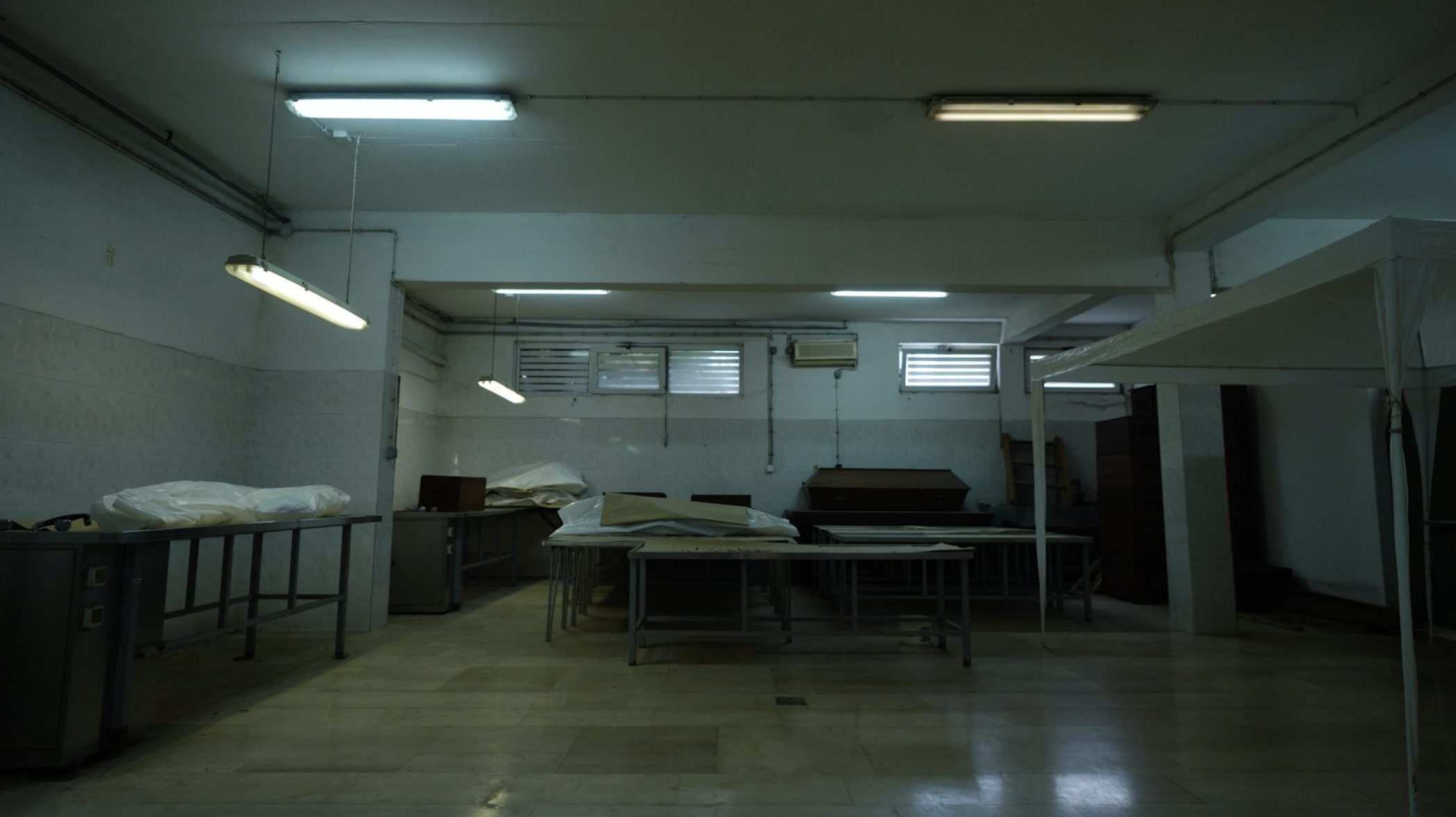This post is also available in: Bosnian
Two-and-a-half years after the Court of Bosnia and Herzegovina confirmed the first indictment for genocide, it is due to pronounce a verdict in the case on July 29.
The State Prosecution charges Milos Stupar, Milenko Trifunovic, Petar Mitrovic, Brane Dzinic, Aleksandar Radovanovic, Slobodan Jakovljevic, Miladin Stevanovic, Velibor Maksimovic, Dragisa Zivanovic, Branislav Medan and Milovan Matic with complicity in genocide.
The prosecution considers that Stupar was commander of the Second Special Police Squad, while nine other indictees were members of the same squad and Matic was member of the Republika Srpska Army, VRS.
The indictment alleges that the 11 men participated in capturing and escorting in a column about 1,000 civilians, who were then taken to the Agricultural Cooperative in Kravica village. There they were shot dead in the evening hours of July 13, 1995.
Witness Richard Butler, military analyst of the Hague Prosecution, said the Special Police forces were under the command of the VRS on July 13, adding that these forces participated in “Krivaja 95”, a military operation whose aim was “narrowing the protected zone, so that it included Srebrenica town only, and cutting its communication with Zepa”.
Like Srebrenica, Zepa and Cerska were UN-protected zones, or enclaves, in eastern Bosnia, where the local mainly Bosniak population, now including large numbers of refugees, had been disarmed in return for UN assurances that the enclaves would remain safe from Bosnian Serb attack.
Butler said that Bosnian Serb Interior Ministry forces became engaged as of July 10, “when the VRS became aware of the fact that it could not occupy the area”. The Special Police forces, including the Second Squad from Sekovici, arrived in Bratunac on July 11. On the two following days these units, acting under the command of the VRS, were distributed to positions alongside the road leading from Konjevic Polje to Kravica.
Joint defence witness Tomislav Kovac, who was Deputy Interior Minister of the Republika Srpska from August 1994 to August 1995 and Interior Minister until December 1995, explained that he found out about “the VRS’s intentions related to the Srebrenica area” in July 1995, “when the RS President, Radovan Karadzic, requested the engagement of the Internal Affairs Ministry forces in that area”.
Prosecution witness Dragomir Vasic, former chief of police ofthe RS and Srebrenica war crimes suspect, claimed he received an order issued by Tomislav Kovac on July 10, 1995.
”The mentioned order stated that a military operation in Srebrenica area had begun and all units, including the Second Special Police Squad from Sekovici, were to participate in the attack,” he said.
Prosecution and defence witnesses gave contradictory statements when they spoke about the units that were present in the area when the shooting took place.
The massacre survivors maintained they were “Serbian soldiers or policemen”, while former VRS and police members who appeared as witnesses claimed that members of paramilitary groups and “some other soldiers with Serbian accents” were present in Kravica.
Prosecution witness Hajra Catic was on a bus, which was evacuating women and children from the town on July 13. As indicated by Catic, when the bus passed through Sandici village, she saw about 300 captured men, guarded by Serbian soldiers, on a meadow.
“We also saw columns of Muslims who were being taken towards Kravica by Serbian soldiers,” the witness recalled. As stated by many witnesses, the civilians murdered in Kravica were either captured or surrendered when trying to leave Srebrenica. After capture, they were taken to a meadow in Sandici village.
“Using a public address system, the Serbs called upon us to surrender. They claimed that they would not harm us and UNPROFOR would escort us to Tuzla,” Enver Husic recalled.
“Most men decided to surrender. When we came to the meadow, more than 1,000 men had already been there. There were many wounded people. Due to the extreme heat, you could smell blood,” Husic added.
Husic, who was only 17 in July 1995, managed to get on a bus, while his father remained in Sandici. His remains have still not been found.
Ratko Mladic visited the prisoners held in Sandici, witnesses recalled. “He told them not to worry, adding that their families were taken to safe locations and that they would be able to join them as soon as the transportation means were available,”witness Slobodan Mijatovic, a former member of the Military Police a who escorted general Mladic, said. “The prisoners then started applauding and shouting‘cheerio’.”
Witnesses said after Mladic had left, armed men dressed in civilian clothes escorted the prisoners to a hangar in Kravica.
S1 and S2, who survived the ensuing massacre, described what happened.
“The hangar was totally full. Then we heard shooting,” S1 recalled. “I closed my eyes waiting for them to kill me. All the men fell tothe ground. I lay down as well. There was blood everywhere. While I was lying on the floor, I heard groans, cries for help and screams. The situation was chaotic.”
S1 survived the mass execution because his body was concealed by the dead bodies of other prisoners.
Following the shooting and bomb throwing, which “lasted for about an hour”, S1 stayed on the ground among the corpses, listening to noises,which included laughter, coming from outside.
”I lay on a dead man and managed to cover myself by putting two corpses over my body. I stayed there for the next 24 hours,” said S1, who managed to get out of the hangar on July 15, when he moved towards the woods, accompanied by witness S2. They walked for about 11 days before leaving the territory controlled by the Serbian forces.
Protected witness S2 was wounded during the shooting but also survived.
”It was a living hell,” he said. “Nobody knew what was happening to others. You could hear screaming, crying for help and shouting. After having been shooting for a while, they took a break, went out and had a cigarette. Then they returned and started shooting again, killing the remaining prisoners.”
While he was lying there, waiting for an opportunity to escape, this witness said he heard the soldiers looking for survivors among the corpses.
“I heard some of them saying something and getting out of the hangar. Then I heard shooting and I heard them dragging the dead bodies back. After that, dredgers came to collect the corpses,” witness S2 recalled.
Prosecution witness Luka Markovic, who worked in the Agricultural Cooperative, said that 18 buses drove the men to Kravica, adding that there were “about 1,000 people” in the hangar.
“When the indoor part was full, they locked the door and started bringing people to the outside part of the hangar,” Markovic said.
“I heard shooting and somebody shouting ‘Allahu ekber’. The prisoners attackedthe guards. Those who were standing by the gate started shooting. Half an hour later, all those who were held in the open part of the hangar were killed.Then, they started killing those who were locked indoors.”
Ilija Nikolic said that after one of the prisoners killed a policeman with a gun, the others then shouted ‘Allahu ekber’ and attacked the guards, who then started shooting at them.
However, S1 denied that the Serbs responded to an attack, saying the only shooting he heard was“when they started shooting us”.
Former Agricultural Cooperative Director, Jovan Nikolic, visited Kravica shortly after the shooting.
“I was a few metres away from a group of prisoners, when a soldier ordered them to lie down,” he said.
“He then killed them all. I saw lifeless bodies of the killed people inside the hangar. I could not see the floor because there were so many corpses on it. They quickly transported them to Glogova location. A few days later two cisterns came and washed the hangar.”
Zoran Eric, who was serving his army duty when the shooting in Kravica took place, said that he did not witness the shooting but heard people detained in the hangar screaming “Give us water” and “Mother, help me”.
The following day, on July 14, Eric and other soldiers covered “about 200” corpses with hay in front of the hangar, “so that UNPROFOR soldiers would not be able to spot them”.
As stated by witnesses, as per an order issued by Bratunac Brigade, members of the Civil Protection Unit removed the corpses. Protected witness S3 was among the Civil Protection members.
“Had I known I would be driving corpses, I would not have come there at all,” S3 said. “After they had loaded the bodies onto our trucks, they ordered us to drive them to Glogova village. When we got there, we were met by some soldiers. A grave, which was about 50 metres long and 2.5 metres wide, had already been dug. A few corpses had already been put in it.”
Dragomir Mirkovic, former director of the Communal Services Company from Bratunac, said that “between 500 and 600 corpses” were buried in Glogova grave.This defence witness said that during the course of the war, his workers“buried human and animal corpses” or, in other words, they performed“sanitation of the terrain”.
The Communal Company had been invited by Colonel Ljubisa Beara, who is currently on trial for his role in Srebrenica at The Hague.
“When the digging commenced, trucks started bringing corpses,” Mirkovic said, adding that, on the same day,he saw “an incident” in Kravica on his way towards Konjevic polje.
“I saw a stack of killed people and a man wearing camouflage uniform killing some people who were lying on the ground,” Mirkovic recalled.
An ICTY investigator Dean Manning, testifying before the Court of Bosnia and Herzegovina via video link,said there was a possible link between the Glogova grave site and Kravica.
“We have got evidence to prove that Glogova grave and the related secondary graves could be associated with Kravica and not with other execution locations,” he said.
“We managed to determine an absolute compatibility between the materials found in Kravica and those found in the graves.”
According to court experts’ findings, most corpses from the hangar in Kravica were buried in Glogova 1 grave, from which 191 bodies and 283 body parts were exhumed in 1999, and Ravnice mass grave, in which 32 persons and approximately 148 body parts were discovered during exhumation in 2000.
Besides the bodies of the killed people, some pieces of armed concrete, door frames and parts of the door, identical to those found in Kravica hangar,were found in the Glogova grave.
In its closing arguments the State Prosecution called for a maximum 45-year sentence to be pronounced against the indictees. The defence said release of the suspects would the only “adequate” verdict in this case.
Merima Husejnovic and Nidzara Ahmetasevic are BIRN – Justice Report journalists. Justice Report is BIRN online weekly publication.
- Case: Kravica
- City: Kravica
- City: Srebrenica
- Person: Dzinic Brane
- Person: Jakovljevic Slobodan
- Person: Maksimovic Velibor
- Person: Matic Milovan
- Person: Medan Branislav
- Person: Mitrovic Petar
- Person: Radovanovic Aleksandar
- Person: Stevanovic Miladin
- Person: Stupar Milos
- Person: Trifunovic Milenko
- Person: Zivanovic Dragisa
- War crimes




